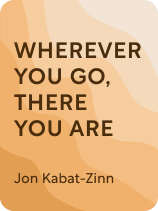

This article is an excerpt from the Shortform book guide to "Wherever You Go, There You Are" by Jon Kabat-Zinn. Shortform has the world's best summaries and analyses of books you should be reading.
Like this article? Sign up for a free trial here.
What are the best Wherever You Go, There You Are quotes? Are you curious about mindfulness, but don’t know where to start?
Wherever You Go, There You Are by Jon Kabat-Zinn offers an introduction to mindfulness as well as practical strategies for incorporating mindfulness into your daily life. Kabat-Zinn argues that many of us exist in a constant state of distraction, either preoccupied with the past or worried about the future.
To get the main ideas of Wherever You Go, There You Are, check out these quotes below.
Wherever You Go, There You Are Quotes by Jon Kabat-Zinn
Are you curious about mindfulness but don’t know where to start? Are you trying to reinvigorate a mindfulness practice that’s feeling stale? Wherever You Go, There You Are, by Jon Kabat-Zinn, is a guide for anyone who’s interested in exploring mindfulness further, from the tentative beginner to the seasoned practitioner.
Kabat-Zinn is a meditation teacher often credited with bringing mindfulness practice into mainstream public awareness. Wherever You Go, There You Are, which reviewers call a “must-read,” is full of Kabat-Zinn’s reflections on mindfulness and practical strategies for how to incorporate it more intentionally into your life.
Here are three quotes from Wherever You Go, There You Are to help you on your mindfulness journey.
“Mindfulness practice means that we commit fully in each moment to be present; inviting ourselves to interface with this moment in full awareness, with the intention to embody as best we can an orientation of calmness, mindfulness, and equanimity right here and right now.”
The language of mindfulness has become increasingly common in everyday vernacular. But what is it really?
According to Kabat-Zinn, mindfulness is the practice of noticing the present moment and observing it without judgment. Without mindfulness, he argues, many of us move through our day preoccupied with things that happened in the past, worried about things that might happen in the future, or simply caught up in the chaos of our own thoughts. By doing this, we fail to appreciate what’s happening right in front of us.
(Shortform note: Kabat-Zinn uses the terms mindfulness and meditation interchangeably throughout the book. For the purposes of this guide, mindfulness will refer to the overarching practice of becoming aware of the present moment, while meditation will refer to structured mindfulness activities, namely the specific postures and visualizations discussed later on.)
Mindfulness is a tool to interrupt an otherwise habitual lack of awareness by offering the opportunity to pause and notice what’s going on around you and inside you. Kabat-Zinn clarifies that pausing (what he calls “non-doing”) shouldn’t be confused with doing nothing. When we do nothing, time often passes without our awareness; mindfulness, on the other hand, requires deliberate intention and awareness. We can pause when we’re standing still or in the midst of an activity. The key is paying attention to what’s happening and detaching yourself from the desire to control or change the present moment.
“Perhaps the most “spiritual” thing any of us can do is simply to look through our own eyes, see with eyes of wholeness, and act with integrity and kindness.”
This kind of openness requires vulnerability because it requires you to give up the illusion of control and trust that things will unfold as they should. (Shortform note: Some argue that vulnerability depends on trust, but in Dare to Lead, Brene Brown argues that vulnerability and trust are mutually dependent, and occur simultaneously.)
Practicing vulnerability has the additional benefit of making you more generous. As you become more generous and kind with yourself, you’ll also become more generous and kind toward others, allowing the benefits of your mindfulness practice to ripple outward.
(Shortform note: Contrary to Kabat-Zinn’s assertion, one study found that instead of increasing generosity, mindfulness had the opposite effect in some cases, leading to more selfish behavior. The study revealed that participants who were identified as being naturally interdependent-minded—thinking more often about themselves in relation to others—showed more prosocial behavior after a timed meditation. However, participants who were more naturally independent-minded, and thought primarily of themselves as individuals, demonstrated a decreased motivation to help others after the same timed meditation. The increased inward focus of mindfulness seemed to exaggerate their existing egoist tendencies and make it easier for them to ignore the needs of others.)
“Meditation is the only intentional, systematic human activity which at bottom is about not trying to improve yourself or get anywhere else, but simply to realize where you already are.”
Kabat-Zinn offers several visualizations that he uses to support his meditation practice.
First, he describes a mountain meditation. In a seated position, picture a mountain. Notice its shape, its size, its stillness. Imagine the mountain in every season—warmed by sun, covered with snow, and standing firm in the midst of a wild thunderstorm. Notice how the mountain is unchanged as the world moves and changes around it. Continue to breathe, holding the image of the mountain in your mind. Try to bring the image of the mountain into your body, so that you become the mountain you’re picturing.
(Shortform note: The mountain meditation, often attributed to Kabat-Zinn, can be particularly helpful when you’re confronting uncertainty and change. This is a grounding meditation that helps you feel centered even in the midst of turbulent changes. You can find a free guided version of the mountain meditation led by Kabat-Zinn on YouTube.)
The lake meditation can be done either seated or lying down. Start by picturing yourself as a vast lake held by the earth. First imagine the lake perfectly still and mirror-like. Now imagine the lake in a heavy rainstorm or churned up by strong winds. Picture your thoughts as the waves and ripples on top of the lake. Now picture the undisturbed silence below the surface. As you continue your meditation, remember that you embody the entire lake, both the disruptions on the surface and the deep stillness below.
(Shortform note: The lake meditation and other similar water meditations are particularly helpful in managing stress or anxiety because they help you to visualize yourself flowing around obstacles and trusting the flow of your own life. Some practitioners suggest that submerging yourself in water, even if it’s just a bath, can enhance the experience of a water meditation. You can find a free guided version of the lake meditation, led by Kabat-Zinn, on YouTube.)
The loving-kindness meditation is about recognizing that you’re a part of a larger whole, and the belief that if you treat yourself with compassion you can make the world a more compassionate place. Start by focusing on your breath, then expand your attention to encompass your entire being. Imagine holding yourself with love and attention, as you might hold a frightened child. Tell yourself that you’re loved and that you’re worthy of happiness. After directing your compassion inward, direct your attention outward, offering thoughts of compassion to your loved ones, neighbors, and then to anyone who might be suffering.
(Shortform note: The loving-kindness meditation can be particularly helpful when you’re in conflict with another person. For example, Chade-Meng Tan, co-chair of the One Billion Acts of Peace Campaign, explains how he uses loving-kindness meditation as a tool to diffuse conflict by managing his own emotional response. You can find a free guided version of a loving kindness meditation, also known as metta meditation, on YouTube.)

———End of Preview———
Like what you just read? Read the rest of the world's best book summary and analysis of Jon Kabat-Zinn's "Wherever You Go, There You Are" at Shortform.
Here's what you'll find in our full Wherever You Go, There You Are summary:
- A guide to mindfulness for both beginners and seasoned practitioners
- How to incorporate mindfulness more intentionally into your daily life
- How to practice mindfulness through meditation






